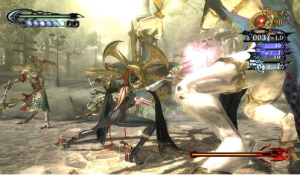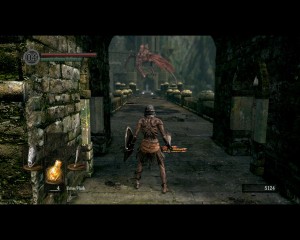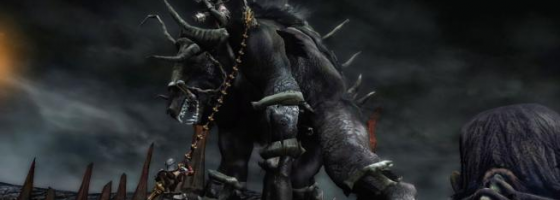Continuing from yesterday’s part, defense is an important mechanic to consider when designing action games, as it can be a used either by new players or expert players. Just like how the flow of an action title has changed, so has defense.
Taking Your Lumps:
The act of defending in an action game has evolved with the genre. In the beat-em-up era there weren’t any mechanics dedicated to solely mitigating damage. Instead your only options were to move out of the way or keep attacking an enemy to prevent them from going into their attack animation.
This of course presented a problem and difficulty spike when it came time for the bosses who you couldn’t interrupt and could just kept on attacking you. Funny enough, this created the strategy of just endless jump kicks to try and whittle down the many bosses of old school beat-em-ups.
As with flow, the first action game to really change the standard of design when it came to defense was Devil May Cry. While many action and beat-em-ups allowed the player to move out of the way of enemies. Devil May Cry was the first fully action title to have a dedicated “dodge” mechanic which allowed the player to move quicker than just pushing the control stick to get out of the way of damage.
Allowing players to quickly attack and then move out of the way of incoming attacks. This trend of avoiding damage became popular among Japanese developed action games like Bayonetta, God Hand and so on. While western developers went with giving the player a block options: allowing them to mitigate damage or null it completely.

Bayonetta was a great action game except in the defensive options. Where enemies were able to supersede her main defensive move.
Titles like God of War, Mark of Kri and etc went this way. You could have a discussion as to what is the better mechanic: Dodge or block?
Many developers feel that dodging requires a higher skill level and offers a higher risk/reward system. As it basically means taking zero damage or full damage.
Interestingly, Ninja Gaiden by Team Ninja gave the player both the ability to dodge and block, but ruthlessly punished the player for blocking by giving just about every enemy some kind of a grapple attack that went through blocks. Effectively to drive the point home that standing in one place equaled death.
When it comes to defensive options, I’m of the opinion that the more the better, as you can design them for different skill levels or rewarding expert players.
For example, the Demon’s Souls series has three systems of mitigating damage. First you can dodge, which your dodge speed is affected by your armor while consuming stamina. Second you can block which different shields can mitigate different percentages of damage types, while consuming stamina.
Or the riskiest was attempting to pull off a riposte, completely avoiding damage while setting the enemy up for a counter hit. But at the same time, failing would mean that you would take the full hit. These three systems forced the player to weigh the pros and cons of each in any given situation. Risk/reward is a big deal as if you want the player to experiment with the tougher moves, there has to be a legitimate reason for risking damage.
A good defensive system should reward the player and make them feel like a badass for getting through combat unscathed. There are however two extremes that you want to avoid: Either making defense too good or not good enough.
If the player has a block that counters all damage, then the game will become boring and the player won’t need to learn any other mechanics to fight. On the other hand if the player has to fight enemies that nullify all their defensive options then we’re just going back to the beat-em-up era of difficulty.
Bayonetta was extremely guilty of the latter, introducing enemies that removed the player’s main defense option of slowing down time. Most games don’t have perfect defensive options as designers are well aware of what would be too easy which is good.
Here is a funny story about defense and making things too good. In the original form of Ninja Gaiden, the developers had a counterattack move that would trigger if the player would block at the right time. After gathering data and realizing that the game was becoming too easy, they actually removed it while making enemies more dangerous in Ninja Gaiden Black. That is the only example I can think of designers making a game harder by removing an entire mechanic.

While not a pure action game, the Souls series use of multiple defensive moves provided a lot of options for combat and added depth.
When it comes to defense, the classic adage:” The Best Defense is a Good Offense” is half true when it comes to action games.
The player should always be reacting either through attacking or using a defensive move, but there should always be some kind of a defensive option.
While it may be awesome to be able to walk into a room and take out everyone, it’s even more bad-ass to do it without taking a hit.



Pingback: Three Components of Great Action Games: Flow | Game Wisdom()
Pingback: Three Components of Great Action Game Design: Enemy | Game Wisdom()